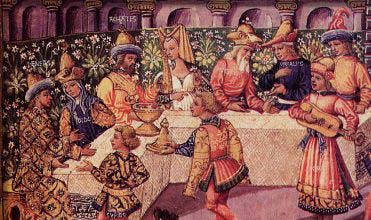| |
Many people have wondered whether Sigismondo Pandolfo Malatesta, the generous and cultured patron of literature and art, were also a patron of culinary art. The lack of documentation makes one suspect that the Malatestas’ cookery, even if it was not so very different from that of other Italian courts, did not enjoy a particularly good reputation.
In Ferrara the wedding feasts of Ercole I and Eleonora of Aragon and of Alfonso I and Lucrzia Borgia are famous. The wedding of Roberto Malatesta, son of Sigismondo, and Isabetta, celebrated with great pomp 25th June 1475, provide the main source of information on Malatesta cookery: the famous ‘list’ that names the raw materials acquired for the wedding feast and , above all, the list of the courses: the menu in fact.
 One must remember that a renaissance banquet consisted of a succession of “servings”, which were not individual dishes but plentiful buffets with everything served at once. The servings were divided alternately into “sideboard servings” and “kitchen servings” (that is cold buffets and hot buffets). It is obvious that the guests were not obliged to devour or even taste everything. For the most noble and fortunate guests at Roberto and Isabetta’s wedding four servings were laid out , followed on top of that by a double post-prandial colation . To begin with there were granitic pine kernel and almond biscuits (“pinochiati” and “marzapani”) cheese and herb flans, roast meat with green sauce (the direct forebear of our salsa verde) and boiled capons with white sauce, a delicate sauce of almonds, eggs and verjuice. Then came, in the second serving, savoury and sweet flans, ham cooked in wine, roast pheasants and peacocks in ‘salsa di pavò’ (the famous salsa peverada, made with chicken livers, crusts of bread, raisins, vinegar and spices) pies and ducks in “salsa ginestrina”
(a delicate kind of pickle with ginger and saffron, from whence its name, as its colour recalls ginestra (broom) flowers. One must remember that a renaissance banquet consisted of a succession of “servings”, which were not individual dishes but plentiful buffets with everything served at once. The servings were divided alternately into “sideboard servings” and “kitchen servings” (that is cold buffets and hot buffets). It is obvious that the guests were not obliged to devour or even taste everything. For the most noble and fortunate guests at Roberto and Isabetta’s wedding four servings were laid out , followed on top of that by a double post-prandial colation . To begin with there were granitic pine kernel and almond biscuits (“pinochiati” and “marzapani”) cheese and herb flans, roast meat with green sauce (the direct forebear of our salsa verde) and boiled capons with white sauce, a delicate sauce of almonds, eggs and verjuice. Then came, in the second serving, savoury and sweet flans, ham cooked in wine, roast pheasants and peacocks in ‘salsa di pavò’ (the famous salsa peverada, made with chicken livers, crusts of bread, raisins, vinegar and spices) pies and ducks in “salsa ginestrina”
(a delicate kind of pickle with ginger and saffron, from whence its name, as its colour recalls ginestra (broom) flowers.
After allowing the guests to get their breath back with a salad of bitter roots, the third serving was brought on, consisting of boiled sturgeon with a grape-juice sauce, large roast fish à l’orange, oysters, marzipan and fruit. The banquet ended with a fourth and last serving of wafers, preserves and “calisoni”, sweet ravioli stuffed with almond paste. At the end of the meal while the dancing began, the fruits of sea and land coated in sugar were passed round and ornate cakes presented: in the form of cherubs, horses, elephants (the Malatestas’ heraldic symbol) and four real masterpieces of a pastry cook’s art which represented the fountain in the square, the Arch of Augustus, Sismondo castle and the Malatesta Temple, “ as it should be built” that is according to Alberti’s definitive design. It is a shame that nothing has remained of this sweet and ephemeral Renaissance.
Renaissance banquets were not purely gastronomic occasions, but show meals to demonstrate wealth and splendour. The waste was programmed therefore. Roberto and Isabetta’s wedding feast – where among other things 8,600 pairs of chickens, 45,000 eggs, 180 hams, 40 Parmesan cheeses, 13,000 oranges and 120 barrels of wine were consumed – cost the enormous sum of 30,000 ducats, invested in celebrating a marriage that was an act of reconciliation between two families, erstwhile deadly enemies.
|